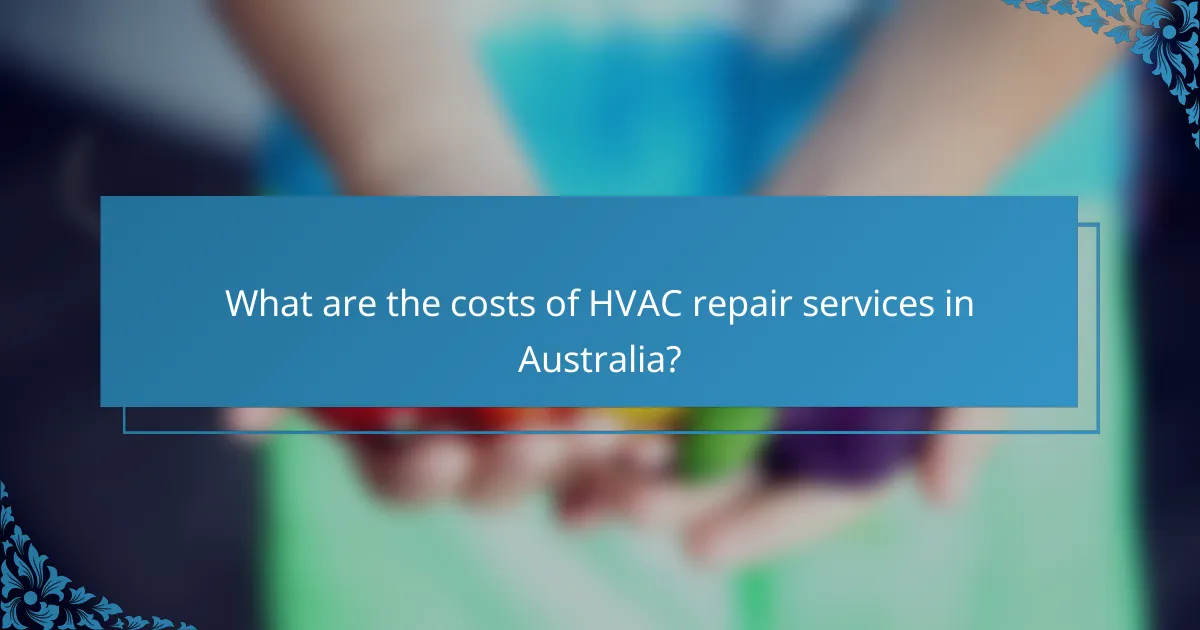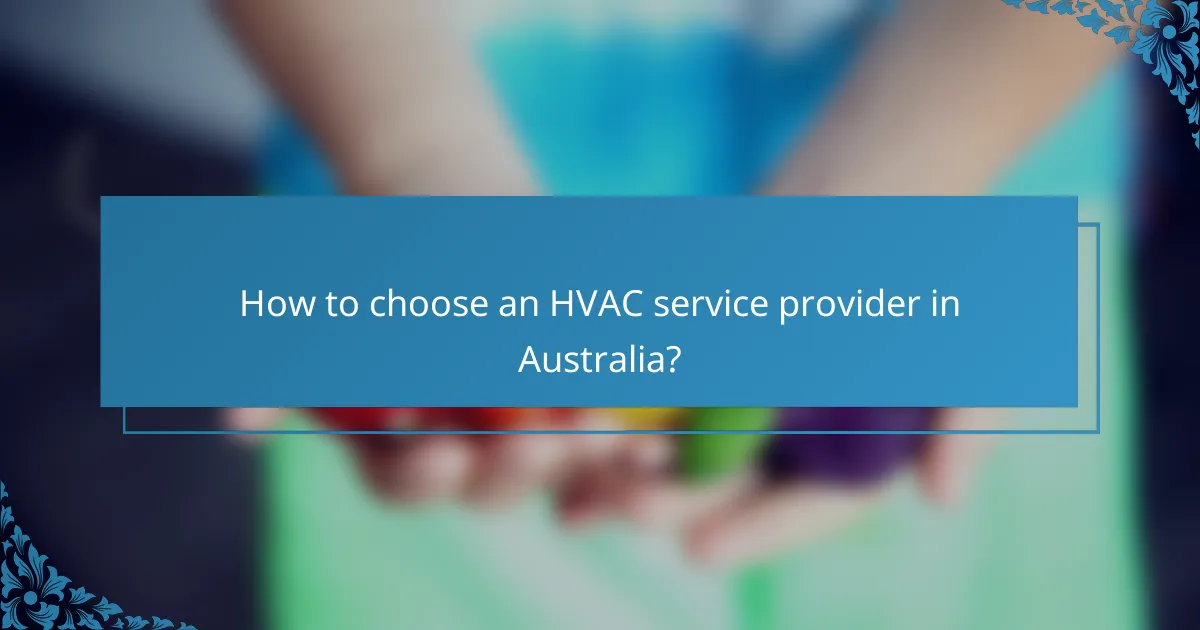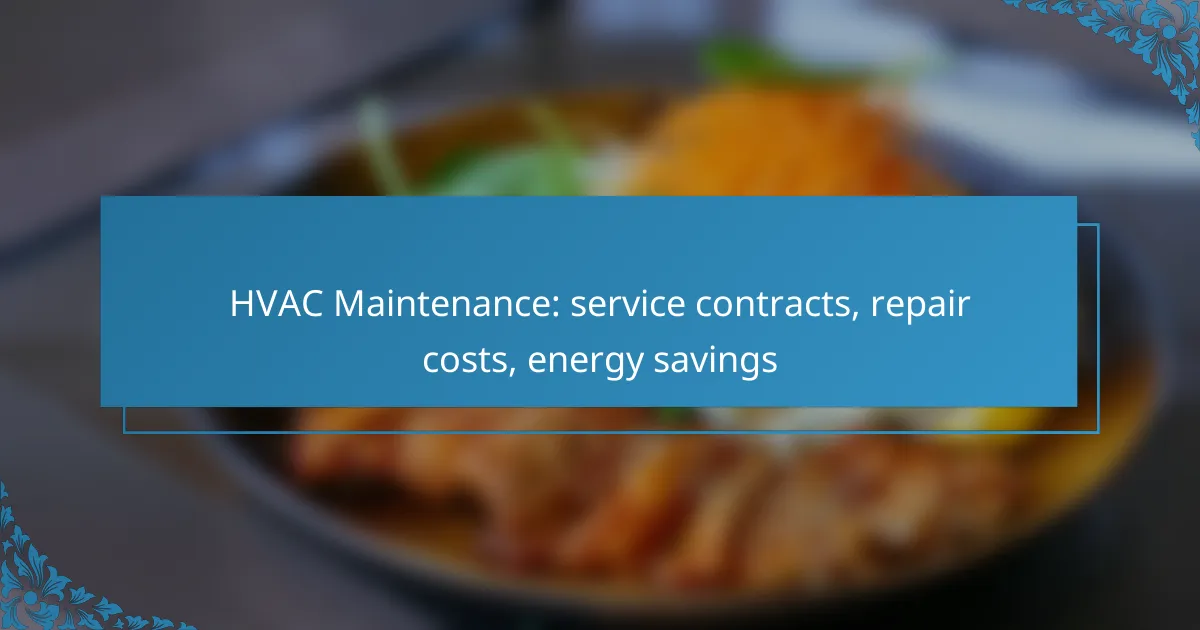Maintaining your HVAC system is crucial for maximizing energy efficiency and reducing utility costs. By investing in service contracts, homeowners can benefit from predictable maintenance expenses and improved system reliability, ultimately leading to significant long-term savings. Understanding the potential repair costs and the advantages of regular upkeep can help ensure your heating and cooling systems operate at their best.

How can HVAC maintenance save energy in Australia?
HVAC maintenance can significantly enhance energy efficiency in Australia by ensuring systems operate optimally. Regular upkeep reduces energy consumption, leading to lower utility bills and a smaller carbon footprint.
Regular filter changes
Changing air filters regularly is essential for maintaining energy efficiency in HVAC systems. Clogged filters restrict airflow, forcing the system to work harder and consume more energy. It’s advisable to check filters monthly and replace them every 1-3 months, depending on usage and filter type.
In Australia, using high-efficiency particulate air (HEPA) filters can further improve indoor air quality while maximizing energy savings. Clean filters can enhance system performance by up to 15%, translating to noticeable savings on energy bills.
System tune-ups
Annual system tune-ups are crucial for keeping HVAC systems running efficiently. A professional technician can identify and fix potential issues, ensuring the system operates at peak performance. This proactive approach can prevent costly repairs and extend the lifespan of the equipment.
During a tune-up, technicians typically clean components, check refrigerant levels, and calibrate the thermostat. These actions can improve energy efficiency by 10-20%, making regular maintenance a smart investment for Australian homeowners.
Smart thermostat installation
Installing a smart thermostat can lead to significant energy savings by optimizing heating and cooling schedules. These devices learn user preferences and adjust temperatures automatically, reducing energy waste when the home is unoccupied.
In Australia, smart thermostats can help manage energy use during peak times, aligning with local energy tariffs. Homeowners can save up to 15% on heating and cooling costs by using these devices effectively, making them a valuable addition to any HVAC system.

What are the costs of HVAC repair services in Australia?
The costs of HVAC repair services in Australia can vary significantly based on the type of repair needed and the specific system in use. Generally, homeowners can expect to pay anywhere from a few hundred to over a thousand Australian dollars for repairs, depending on the complexity and urgency of the issue.
Average repair costs
On average, HVAC repair costs in Australia typically range from AUD 150 to AUD 600 for minor repairs, such as fixing a thermostat or cleaning filters. More extensive repairs, like replacing a compressor or fixing ductwork, can cost between AUD 800 and AUD 2,500. Emergency repairs may incur additional fees, often resulting in higher overall costs.
It’s advisable to obtain multiple quotes from licensed technicians to ensure competitive pricing. Regular maintenance can also help prevent costly repairs in the long run.
Factors affecting repair prices
Additionally, the location of the service can impact pricing. Urban areas may have higher labor costs compared to rural regions. Seasonal demand can also play a role; repairs during peak heating or cooling seasons might be more expensive due to increased demand for services.

What are the benefits of HVAC service contracts?
HVAC service contracts offer several advantages, including predictable maintenance costs and enhanced system reliability. By investing in a service contract, homeowners can ensure their heating and cooling systems operate efficiently, leading to long-term savings and fewer unexpected repairs.
Cost savings over time
One of the primary benefits of HVAC service contracts is the potential for cost savings over time. Regular maintenance can prevent major breakdowns, which can be expensive to repair. By paying a fixed annual fee, homeowners can avoid unexpected repair bills that might arise from neglected systems.
Additionally, many service contracts include discounts on parts and labor, further reducing overall costs. For instance, a typical contract might save homeowners 10-20% on repairs, making it a financially sound choice in the long run.
Priority service access
Service contracts often provide priority access to technicians, which is crucial during peak seasons when demand for HVAC services is high. Homeowners with contracts typically receive quicker response times, ensuring that their systems are serviced promptly when issues arise.
This priority service can be particularly beneficial during extreme weather conditions, where a malfunctioning HVAC system can lead to uncomfortable living situations. With a service contract, homeowners can rest assured that they will receive timely assistance, minimizing downtime and discomfort.

How to choose an HVAC service provider in Australia?
Choosing an HVAC service provider in Australia requires careful consideration of their qualifications, reputation, and service offerings. Focus on finding a licensed technician who has experience with the specific HVAC system you own and offers transparent pricing and reliable customer support.
Check certifications
Ensure the HVAC service provider holds the necessary certifications and licenses required in Australia. Look for qualifications such as the Australian Refrigeration Council (ARC) license, which is essential for handling refrigerants safely.
Additionally, check if they are members of professional organizations like the Air Conditioning and Mechanical Contractors’ Association (AMCA). This affiliation often indicates a commitment to industry standards and ongoing training.
Read customer reviews
Customer reviews provide valuable insights into the reliability and quality of an HVAC service provider. Look for feedback on platforms like Google Reviews or local service directories to gauge customer satisfaction and common issues.
Pay attention to both positive and negative reviews, focusing on comments about punctuality, professionalism, and the effectiveness of repairs. A provider with consistently high ratings is more likely to deliver satisfactory service.

What maintenance tasks are included in HVAC service contracts?
HVAC service contracts typically cover essential maintenance tasks that ensure the efficiency and longevity of heating, ventilation, and air conditioning systems. These tasks often include annual inspections, filter replacements, and system cleaning, all of which help prevent costly repairs and improve energy savings.
Annual inspections
Annual inspections are a critical component of HVAC service contracts, allowing technicians to assess the overall condition of the system. During these inspections, professionals check for any signs of wear, test system performance, and ensure compliance with local regulations.
Regular inspections can help identify potential issues before they escalate into major problems, saving homeowners money in the long run. It’s advisable to schedule these inspections before peak seasons, such as summer or winter, to ensure optimal performance when it’s needed most.
Filter replacements
Filter replacements are essential for maintaining good air quality and system efficiency. Most HVAC systems require filter changes every one to three months, depending on usage and the type of filter used. Regularly replacing filters helps prevent dust and allergens from circulating in the home.
Service contracts often include scheduled filter replacements, which can be a convenient way to ensure this task is not overlooked. Homeowners should consider using high-efficiency filters, which can trap smaller particles and improve indoor air quality.
System cleaning
System cleaning involves removing dust, debris, and other contaminants from various components of the HVAC system, including ducts, coils, and blowers. This cleaning process is crucial for maintaining airflow and system efficiency, as buildup can restrict airflow and lead to higher energy costs.
Many service contracts include periodic system cleaning, which can enhance the lifespan of the HVAC system and improve energy savings. Homeowners should inquire about the frequency of these cleanings and consider additional cleaning services if they have pets or live in dusty environments.

What are common HVAC issues in Australian homes?
Common HVAC issues in Australian homes include refrigerant leaks, thermostat malfunctions, and clogged filters. These problems can lead to inefficient heating and cooling, increased energy costs, and discomfort in living spaces.
Refrigerant leaks
Refrigerant leaks occur when the coolant used in HVAC systems escapes, reducing efficiency and potentially causing system failure. Signs of a refrigerant leak include reduced cooling capacity, ice buildup on the coils, and hissing sounds near the unit.
To address refrigerant leaks, it’s crucial to have a qualified technician inspect the system. They will typically locate the leak, repair it, and recharge the system with the appropriate amount of refrigerant, which is essential for optimal performance.
Regular maintenance can help prevent refrigerant leaks. Homeowners should schedule annual HVAC check-ups to ensure all components are functioning correctly and to catch any potential issues early, saving on costly repairs down the line.
